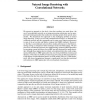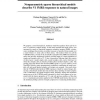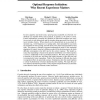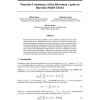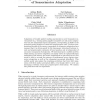133
click to vote
NIPS
2008
15 years 2 months ago
2008
We present an approach to low-level vision that combines two main ideas: the use of convolutional networks as an image processing architecture and an unsupervised learning procedu...
108
Voted
NIPS
2008
15 years 2 months ago
2008
Offline handwriting recognition--the transcription of images of handwritten text--is an interesting task, in that it combines computer vision with sequence learning. In most syste...
107
Voted
NIPS
2008
15 years 2 months ago
2008
We propose a novel hierarchical, nonlinear model that predicts brain activity in area V1 evoked by natural images. In the study reported here brain activity was measured by means ...
NIPS
2008
15 years 2 months ago
2008
In most cognitive and motor tasks, speed-accuracy tradeoffs are observed: Individuals can respond slowly and accurately, or quickly yet be prone to errors. Control mechanisms gove...
97
Voted
NIPS
2008
15 years 2 months ago
2008
We provide a new analysis of an efficient margin-based algorithm for selective sampling in classification problems. Using the so-called Tsybakov low noise condition to parametrize...
86
Voted
NIPS
2008
15 years 2 months ago
2008
This paper presents a theoretical analysis of the problem of domain adaptation with multiple sources. For each source domain, the distribution over the input points as well as a h...
102
Voted
NIPS
2008
15 years 2 months ago
2008
Kernel supervised learning methods can be unified by utilizing the tools from regularization theory. The duality between regularization and prior leads to interpreting regularizat...
NIPS
2008
15 years 2 months ago
2008
Adaptation of visually guided reaching movements in novel visuomotor environments (e.g. wearing prism goggles) comprises not only motor adaptation but also substantial sensory ada...
102
click to vote
NIPS
2008
15 years 2 months ago
2008
We consider the problem of obtaining the approximate maximum a posteriori estimate of a discrete random field characterized by pairwise potentials that form a truncated convex mod...
127
click to vote
NIPS
2008
15 years 2 months ago
2008
Research in animal learning and behavioral neuroscience has distinguished between two forms of action control: a habit-based form, which relies on stored action values, and a goal...
